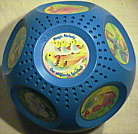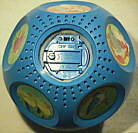Texas
Instruments - Magic Melody/ Der singende Spielball
(a toy that sings with lovely female robot voice)
This ball- shaped toy music box from 1992 plays 6 monophonic melodies
and 6 sung (!) German children songs using a Texas Instruments CPU that
contains a very gritty sounding LPC (speech synthesis) synthesizer (based
on wavetables?). The songs are selected by rotating the ball in a way that
the picture of the selected song faces up. The German name "Der singende
Spielball" means "The singing play- ball".
main features:
-
6 monophonic, short German children song melodies:
-
Ein Männlein steht im Walde
-
Hänschenklein
-
Auf einem Baum ein Kuckuk
-
Backe, backe Kuchen
-
Der Mond ist aufgegangen
-
? (a picture with pears)
-
6 sung German children songs: (unfortunately very short, only 1 stanza
per song)
-
Alle Vögel sind schon da
-
Kommt ein Vogel geflogen
-
Alle meine Entchen
-
Häschen in der Grube
-
Es tanzt ein Bi-Ba-Butzemann
-
Fuchs Du hast die Gans gestohlen
-
song selection by tilt sensors consisting of steel balls rolling in hollow
metal cylinders
-
gritty sounding monophonic LPC (speech synthesis) sound generator with
a charming female voice. The non- sung melodies timbre sounds like a sine
wave signal with much aliasing noise. The CPU (Texas Instruments 305674T,
©1992, CSM 11159AN) has a 16 pin DIP case (no black blob/ COB).
-
unpleasantly resonant (can- like) droning and dull sounding speaker
-
no volume control
-
on/off switch
-
crystal clocked
eastereggs:
-
Shitshooting (by battery wiggling) makes the sound CPU play strange noises
(e.g. similar like poor shortwave radio reception).
notes:
When I bought this toy on flea market, the tilt sensors responded very
badly and only reacted on severe hits or shaking. To open the case I needed
to saw a welded seem between the 2 plastic hemispheres apart, and additionally
there were screws hidden under 4 plastic foil picture stickers (those
got slightly damaged by the removal). Inside is a blue, 5 edge prismatic
(roughly cylindrical) plastic subchassis that is held by shock absorbing
polyethylene foam. The subchassis has the speaker at one end and
the battery case at the other; in between is the PCB, which contains besides
the CPU relatively many discrete parts (resistors, transistors etc.). There
are 5 slanted ball tilt sensors those each consist of a metal cylinder
containing a small and 2 tiny steel balls those roll against an metal end
contact in a certain position. The sensors were coated with a smeary mess
of hardened machine oil, which had insulated them and thus prevented proper
signals. After thoroughly cleaning these parts with soap water and isopropanol
the contacts functioned again, but it was a very unpleasant and fumbly
job to re- assemble the unit, because the balls continuously tend to fall
out of the cylinders, their cables break easily and various small notches
prevent components from being inserted wrongways. This way it needed much
trial and error to re-assemble everything. Now the sensors respond sufficiently
again.
I have absolutely no clue why Texas Instruments as well screwed
as welded the case tight; possibly they thought that children toss this
ball- like toy around so badly that case would crack apart when only held
by screws. IMO this is one of the most awkward to repair electronic toys.
I guess that at the bottom a detachable battery cover with a 12th picture
is missing, because there are still the notches to hold it.
The hardware has much similarities with my yellow animal train sound
toy, which also uses a similar Texas Instruments CPU to synthesize
gritty animal voices. Unlike the latter, I didn't add modifications to
the Magic Melody ball, because its hardware is very awkward to dismantle
and (unlike the animal train) likely badly suited as an instrument. But
I love the gritty, charming, grandma- like electronic voice of this toy
- it reminds to strange science fiction fantasies about a robot nurse or
the like.
| removal
of these screws voids warranty... |
|
|
 |

|
|
| |
back
|
|




